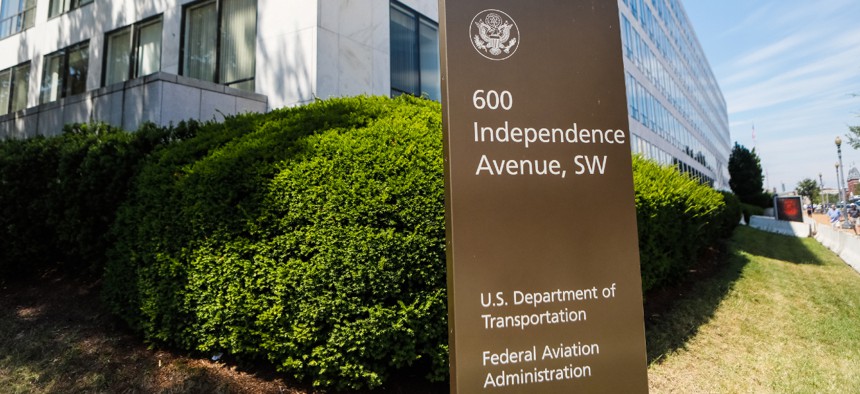
FAA officials say they plan to hire more than 1,500 controllers this year and are “reducing the backlog of training caused by COVID-19.” P_Wei/Getty Images
FAA-Caused Flight Delays in New York Preview Potential 'Crisis' in Coming Years
The agency says it is addressing staffing shortages that have contributed to an unusually disruptive summer, but groups warn FAA is not sufficiently planning.
The Federal Aviation Administration caused significant delays in the New York area on Monday after it forced ground delays due to staffing shortages, marking another disruption in a summer already marked by unusually high levels of flight delays and cancellations.
While federal workforce issues account for only a portion of the issues that have plagued the nationwide system at times struggling to ramp back up from the two-year downturn caused by the pandemic, the shortages have forced multiple periods of widespread interruptions. Federal officials and employee groups have cautioned this could represent only the tip of the iceberg, with the entire system facing a chaotic future if the problems go unresolved.
FAA said on Monday it was forced to lighten aircraft traffic at New York City’s three major airports due to staffing shortages, leading to significant delays. Transportation Department Secretary Pete Buttigieg acknowledged the larger issue in a recent interview with CNN, saying recent disruptions caused by weather should not have made such a widespread impact.
“That is something that to me is an indication that we still have not seen the improvements that we need, that the system is very brittle," said Buttigieg, who deflected blame primarily to the airline industry.
Rich Santa, president of the National Association of Air Traffic Controllers, said in an address last month at the Aero Club in Washington that many factors have impacted FAA operations this summer. Those include unprecedented weather disruptions, a spike in commercial space launches and reentries and airline operational issues. Also at the top of the list, however, is FAA’s staffing, which has declined for years and seen a particular impact by the agency turning the spigot off and back on due to the COVID-19 pandemic.
“Just like during sequestration and the 35-day government shutdown, the pandemic again forced FAA to suspend hiring and temporarily close its training academy,” Santa said. “This has negatively affected staffing.”
In 2011, including trainees, FAA had more than 15,000 controllers on board. That has dipped for the last 11 years and has now dropped by 10%. Santa said the system should have instead grown by the same amount to keep pace with a busier airspace. He also accused FAA of juking its statistics, counting trainees who may never become fully certified to make some locations appear fully staffed when they are not. The Jacksonville Air Traffic Control Center, he said as an example, which services parts of Florida, Georgia, Alabama, South Carolina and North Carolina, maintains a target staffing level of 275 certified controllers. It currently has only 205, but counts 50 additional trainees to appear closer to its goal. Santa called on FAA to provide more transparent staffing numbers to allow the agency to allow the union and management to ensure accurate targets and adequate preparation for attrition.
So far, Transportation data show delays tied directly to the national aviation system—rather than weather, airline issues or security problems—account for a relatively small portion of delays, at about 17% for 2022. The data is only current through May.
“Airlines’ data show that the vast majority of delays are not due to air traffic controller staffing,” FAA said in a statement. “Where demand has increased, the FAA is adding additional controllers.”
The agency noted it plans to hire more than 1,500 controllers this year and is “reducing the backlog of training caused by COVID-19.”
Even if FAA can address that issue, however, travelers could still experience widespread delays and cancellations thanks to even more dramatic cuts to another part of FAA’s workforce. Nearly one-in-four technician positions that service all the electronics and equipment that air traffic controllers depend on have been cut over the last several years. Dave Spero, president of Professional Aviation Safety Specialists, said the reductions have yet to cause significant disruptions to air travelers, but the system is “quickly approaching a crisis.” Spero also cited a lack of attrition planning and said the agency has doubled its trainees on board, requiring fewer certified technicians spending more time getting new hires up to speed.
Soon, he said, the agency will come to a point in which a specialist is not available to address an acute problem, and it will upend the entire system. If the lighting system that guides pilots at Hartsfield-Jackson Atlanta International Airport requires technical fixes and FAA does not have staff available to address it, Spero said as an example, the ripple effects would be “catastrophic.”
“You will start to see delays very, very quickly,” he said. “Without this technical workforce, the national airspace system can’t work.”
The House has passed a fiscal 2023 spending bill along party lines that would give FAA some new money for hiring and which pressed the agency to develop a multi-year workforce plan “for all technical operations positions to establish current and future workforce needs to preserve performance standard of FAA facilities and equipment.” The bill will undergo changes as the Senate and congressional leaders negotiate a final package.







